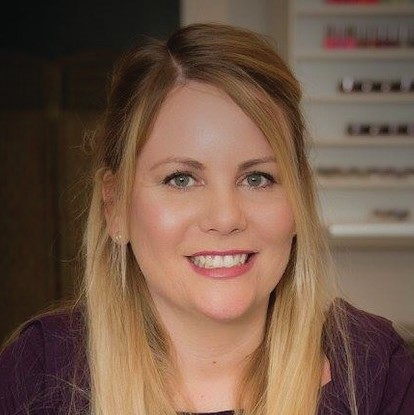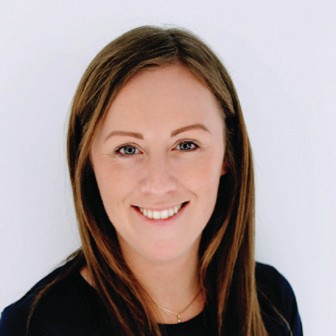BUSINESS MATTERS
HIRING HELP
Are you seeking a new staff member but unsure how to nail the recruitment process? Check out REBECCA HITCHON’S roundup of advice
Is your nail business in a position to recruit? Perhaps you wish to introduce more clients to your salon services, expand your treatment menu or ease the workload of yourself and employees. Whether you’re seeking permanent or temporary staff, the hiring process features many stages, which are important to perfect in order to find a good fit for your company.

Linda Hill
“It’s time to recruit when you are oversubscribed with a waiting list of clients, but simply don’t have enough staff to accommodate their needs. Calculate how many clients you are turning away each month and the lost revenue,” advises Linda Hill, founder of award-winning aesthetic & beauty recruitment agency, Linda Hill Recruitment. “Or, if you’re juggling so many tasks that you feel overwhelmed, tired and frustrated, hiring someone to split the workload may provide you with more time, energy and a clearer mind to focus on what you love.”
But how can you boss the recruitment process? Let’s explore...
Promoting a position
One in 10 people find jobs through social media, according to business service marketplace, Clutch. There are many ways to advertise a job vacancy: from networking to posting physical and digital ads and using a recruitment agency, but one of the advantages of social media is that it costs nothing.
“We advertise positions on our social media channels, as those who are passionate about working for us follow these for vacancies, and followers often tag their connections in the posts, helping to spread the word,” reveals Samantha Beatty, owner of Beauty at the Gate in Holton-le-Clay, Scratch Stars Nail & Beauty Salon of the Year 2023. “We often approach our local college, too, where we find therapists at Samantha Beatty the start of their professional journeys. We are not looking for the most qualified candidates, as we offer extensive training; we want to employ professional and ambitious therapists with character, passion and personality.”

So, what should your job advert include? “You’ll need a short, snappy heading that sums up the vacancy, strong imagery that represents your brand and business culture, and an accurate summary of the job including level of seniority, qualifications required and main responsibilities,” comments a spokesperson for the National Hair & Beauty Federation (NHBF). “Also, don’t use descriptions that discriminate against groups of people. For example, you can’t advertise for a ‘bright, young female stylist’.”
“When advertising a role, put yourself in the shoes of a job seeker, as they will be thinking ‘WIIFM’ (what’s in it for me),” details Linda Hill. “Instead of listing the job’s responsibilities or your company’s accolades, focus on how the role can benefit the candidate. For instance, mention opportunities for growth, learning and personal development and perks such as treatments or products at cost price.” She notes that ambiguity in job postings will deter potential employees and make hiring time-consuming. “By specifying critical details, you attract applicants who are genuinely interested and well-informed about the position. Candidates scan job ads for three things: salary, location and hours, especially if they need childcare support or have other responsibilities outside of work.”
Employee musts
According to LinkedIn, soft skills like communication, teamwork, time management and problem-solving featured in 78% of job descriptions over a three-month period in 2022. “While technical skills are important, soft skills will determine how well a candidate slots into your team, gets on with clients and adapts to changes,” says Linda Hill. “An employee who resonates with your company ethos is more likely to be engaged, productive and loyal.”

Michelle Brookes
“On a CV, I always look at past employment history,” adds Michelle Brookes, Louella Belle educator & owner of Michelle Brookes Training Academy and Beauty Lounge, Doncaster. “If an applicant has jumped from job to job or has gaps in employment, this may be a cause for concern. Also assess the presentation of their CV: does it look professional and make a good first impression, and has it been personalised to the role?”
AI & recruitment

Caroline Gleeson
While aspects of the hiring process can be time-consuming and it might seem easy to turn to artificial intelligence (AI) – a technology increasingly being used to tackle administrative tasks, the importance of human intervention cannot be underestimated. “Humans excel in assessing cultural fit, interpersonal dynamics and understanding organisational values: facets that go beyond the capabilities of AI,” notes Caroline Gleeson, CEO of recruitment software company, Occupop. “AI can screen applicants to find those who fit specific criteria, but choosing the right candidate often means looking at more than work experience. Human touch can help better determine who you want to interview. Similarly, while AI can be used to write emails and provide interview feedback, a person-to-person approach is often more welcoming.”
Recruitment case study
Glasgow-based beauty training provider, The Academy, runs a trainee programme in partnership with UK hotel and spa groups, to develop future therapist talent and boost recruitment. Successful applicants – who require no previous experience in the spa industry – are offered learning within The Academy and at an allocated hotel or spa, remote theory education and a Confederation of International Beauty Therapy and Cosmetology (CIBTAC) exam upon completion of training. They are offered employment by their allocated hotel or spa during the programme and once it and the CIBTAC exam are concluded. One of the first students trained under the programme was named CIBTAC Student of the Year 2023. www.the-academy.co.uk
Check out the NHBF’s recruitment & employment guide, free to download for members and £50 for non-members
Screening success
Interviews
“Save yourself unnecessary face-to-face interviews with unsuitable candidates by doing an initial screening over the telephone,” suggests a spokesperson for the NHBF. “You’ll learn a lot about candidates’ technical skills, confidence levels, professionalism, communication skills and speaking styles. Don’t ask questions that may be discriminatory, for example about place of birth, ethnicity, religion, marital status, children or pregnancy, sexual orientation, age, medical conditions or lifestyle choices.”
Linda Hill advises making a confirmation call the day before a face-to-face interview, not only to serve as a reminder, but to gauge the candidate’s continued interest and availability. “When carrying out interviews, have a structured, consistent format to make it easier to compare candidates, and so you can be clear about the responsibilities of the role, growth opportunities and company culture,” she says. “Then decide on your non-negotiables. For instance, are you willing to train an employee in certain treatments if their personality and attitude matches what you are looking for?”
“I always start by asking an interviewee why they want to work at my salon, what they can bring to the brand and what they know about it, to see if they’ve done their research,” reveals Michelle Brookes. “It’s important to check if a candidate will gel with the existing team, so I regularly have a senior member of staff in the interview. This also means that the person already knows a supportive face if they are offered the role. Interviewing within the workplace is the best way for a business to present what it is like to potential employees.”
“It’s crucial that interviewees are made to feel comfortable from the onset,” explains Samantha Beatty. “If they are nervous, you won’t see the best version of them, therefore could miss out on a great staff member. We like to introduce candidates to members of our team to make them feel relaxed and show off our therapists and their achievements as employees.”
Trade tests
“Trade tests can be a great way to gauge candidates’ skills in a practical and targeted way,” continues the NHBF spokesperson. “The key is to be prepared; make sure you tell candidates what will be provided, what they need to bring, timings and exactly what you will be looking for. Make a checklist of the skills you are seeking so you can quickly rate the candidates’ performances, and jot down comments during the tests so you can easily review and provide feedback to applicants afterwards.”
“By finding out a candidate’s strengths prior to their trade test, we base the test around the technical skills they are most comfortable with,” reveals Samantha Beatty. “We want to see what they do best and as long as they have the right attitude, we can work on areas they want to improve on.”
“When carrying out trade tests, I either bring in models and watch parts of the treatment take place, or ask a member of my team to have a treatment,” Michelle Brookes comments. “Trade tests show how candidates interact with clients. One of the best trade tests I’ve seen was with my now employee, Abby. She finished her treatments and went into the kitchen to pack away, where she completed a few general salon jobs. I was impressed with her initiative.”